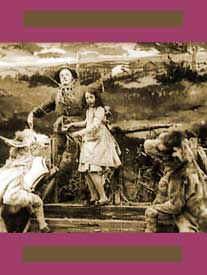 Identites of the actors & even the director are tentative only, as records are skimpy for The Wonderful Wizard of Oz (1910), the oldest surviving film version of L. Frank Baum's story. I'll cite the usual suspects for each role, but there is considerable argument about this.
Identites of the actors & even the director are tentative only, as records are skimpy for The Wonderful Wizard of Oz (1910), the oldest surviving film version of L. Frank Baum's story. I'll cite the usual suspects for each role, but there is considerable argument about this.
The film is twelve minutes long & is available with a piano score adapted from a 1902 stage musical which inspired many of the sequences, though the film is not quite an adaptation of that play.
This antic short-film adaptation was initially part of a quintology, but the other three films, Dorothy & the Scarecrow in Oz, The Land of Oz, & John Dough & the Cherub (all 1910), are not known to survive. Baum had no input into these films, which were arranged through a bankruptcy court.
The tale begins on the farm of Aunty Em (Winnifred Greenwood), with several farm-animal costumed characters. Dorothy (Bebe Daniels) liberates Scarecrow (Robert Z. Leonard) from his perch in a field while a storm is brewing.
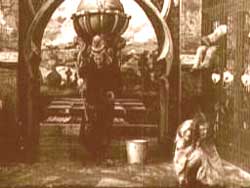 Dorothy, Scarecrow holding Toto, & a couple farm animals (Hank the Mule & Imogene the Cow) take refuge in a haystack when the tornado is coming. Dorothy, Scarecrow holding Toto, & a couple farm animals (Hank the Mule & Imogene the Cow) take refuge in a haystack when the tornado is coming.
They're all blown to the Land of Oz, where Momba the Wicked Witch (Eugenie Besserer) has been causing problems for the Wizard (Hobart Bosworth), wacking him with her broom among other things.
Glinda the Good Witch (Olive Cox) appears to Dorothy in the woods, & turns little Toto into a big mastif, or a guy in a mastif or bulldog suit, so that the dog can be a protector.
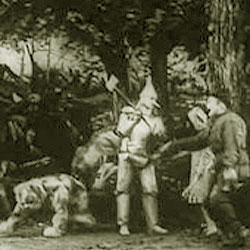 Big Toto befriends the Lion, plus there's the giant kitty-cat Eureka. Off they all go, farm animals, wild animals Scarecrow, & Dorothy too, finding the Tin Woodman (Robert Z. Leonard) rusted solid. After being oiled he joins the troupe. Everybody dances happily. Big Toto befriends the Lion, plus there's the giant kitty-cat Eureka. Off they all go, farm animals, wild animals Scarecrow, & Dorothy too, finding the Tin Woodman (Robert Z. Leonard) rusted solid. After being oiled he joins the troupe. Everybody dances happily.
Momba the witch lives further on, in a really cool hut guarded by a chap in a draco flying lizard costume. Right away Dorothy figures out water is the witch's enemy so that's all settled right quick.
Arriving at the Emerald City where she becomes queen, & Scarecrow is made king, there'll now be good rulers over Oz even after the Wizard returns to Omaha which he's been missing.
Off goes the Wizard in his balloon & hooboy is Dorothy glad never to see that boring old farm again, for after all, there's no place like Oz, there's no place like Oz.
The Wonderful Wizard of Oz is lively fun & is surprisingly similar to old English pantomime. Indeed some of the costumes may have pre-existed. Eureka the cat, for instance, might easily have been Dick Whittington's Cat from the pantomime theater.
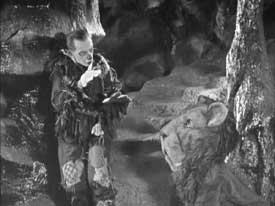 Violet MacMillan plays Dorothy in the silent film His Majesty the Scarecrow of Oz (1914), the scenario having been written by L. Frank Baum himself.
Violet MacMillan plays Dorothy in the silent film His Majesty the Scarecrow of Oz (1914), the scenario having been written by L. Frank Baum himself.
It takes its main cues from the book The Scarecrow of Oz (1915). It was made for Baum's own shortlived film studio, into which he sunk funds from the successful books & bankrupted himself.
King Krewl (Raymond Russell) rules Oz to everyone's misery. His niece Princess Gloria (Vivian Reed) is about to be forced to an unwanted marriage.
She is in love with the gardner's son Pon (Todd Wright), whom King Krewl chases away in favor of the horrible but wealthy Googly-goo (Arthur Smollet).
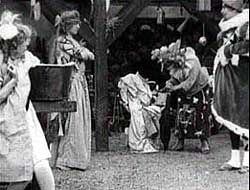 Dorothy meanwhile is enslaved by Mombi (Mae Wells) the one-eyed Wicked Witch. She'll eventually be liberated by Pon, & they will set out together to save the princess. Dorothy meanwhile is enslaved by Mombi (Mae Wells) the one-eyed Wicked Witch. She'll eventually be liberated by Pon, & they will set out together to save the princess.
King Kruel seeks an anti-love potion from Mombi. The witch literally freezes Gloria's heart, rendering her immune to mortal love.
It's up to Dorothy & Pon to undue the harm, assisted by the Scarecrow (Frank Moore) recently animated by fair maidens dressed like Indians (or campfire girls of the era, who wore just such costumes); by the rusty Tin Woodman (Pierre Couderc), & eventually the Wizard (J. Charles Haydon), who traps the witch in a can using magic writing involving an amusing pun.
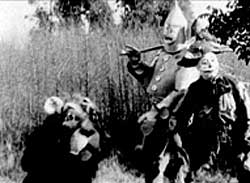 Fun because of its great age, His Majesty the Scarecrow of Oz is awfully primitive, sloppily photographed, & hoky, needing some forgiveness to fully appreciate. Fun because of its great age, His Majesty the Scarecrow of Oz is awfully primitive, sloppily photographed, & hoky, needing some forgiveness to fully appreciate.
If you get yourself in a suitably childlike frame of mind, it manages suspense when Princess Gloria's heart is frozen, because it's just way sad that she stops loving Pon.
It's also appealing to see the little boy Button Bright, who is lost but doesn't care, played by a girl, Mildred Harris who would one day marry Charlie Chaplin.
And then there's the antic costume performances of Fred Woodward variously as a giant crow, the mule, the cow, the cowardly lion, & when Pon gets turned into a kangaroo, it's actually Woodward in the 'roo suit.
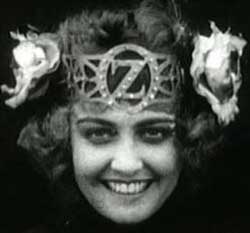 Fairies gather in the moonlight in the Forest of Burzee, in The Magic Cloak of Oz (1924). The script was written by L. Frank Baum himself, though he finds fairly loose touchstones from his original story Queen Zixi of Ix; or, The Story of the Magic Cloak (1905), which Baum considered his best fairy tale.
Fairies gather in the moonlight in the Forest of Burzee, in The Magic Cloak of Oz (1924). The script was written by L. Frank Baum himself, though he finds fairly loose touchstones from his original story Queen Zixi of Ix; or, The Story of the Magic Cloak (1905), which Baum considered his best fairy tale.
The fairies are depicted as transluscent women in white robes dancing in a circle. They have woven a magic cloak which will grant one wish to whoever wears it. The Man in the Moon suggested the fairy maidens give the cloak to the unhappiest individual who lives.
A young girl named Fluff (Mildred Harris) lived by Vinegar River with her family. Her father operates the ferry. Her little brother is Bud (Violet McMilland playing a boy). Their playmate is Nicodemus the donkey (very ably played by Fred Woodward in a donkey constume).
Aunt Rivette (Mai Wells) is the village washerwoman. By second sight she saw beforehand that her brother would drown, & her niece & nephew would become orphans. Afterward she moved with the kids to the City of Nole, capital of Noland, where the king recently died.
Fluff the Fairyman's Daughter wept so long & hard over the loss of her home that she won the coat as unhappiest person. She wished to be happy once more.
It was the custom of the city that upon a king's death, the 47th person through the gate would become the new King of Noland. Bud is the 47th person through the gate, hence the new king, & his family goes instantly from destitute beggars to a wealthy privileged royal family living in a palace.
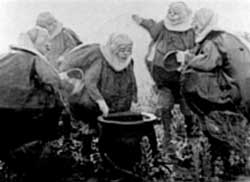 Donkey Nicodemus disliked city life & wanted to go back to their humble riverside home. On his way he was waylaid by robbers, who have a forest camp where they play jacks, & where they have a kidnapped little girl, Mary. Donkey Nicodemus disliked city life & wanted to go back to their humble riverside home. On his way he was waylaid by robbers, who have a forest camp where they play jacks, & where they have a kidnapped little girl, Mary.
Nick encounters "the lonesome awful Zoop" who looks remarkably like the Grinch crossed with the flying monkeys of Oz. Nick also meets a lion (Hal Roach of all people is in that particular costume). Later a friendly giant crow joins the crew, plus others, such as Kangaroo, Elephant, & the Hungry Tiger.
They are becoming a wonderful set of costume-characters. These figures defeat the robbers. Mary's much obliged to be saved.
Bud & Fluff meanwhile bankrupted the royal coffers buying toys for themselves & for all the kids in the city.
Zixi (Juanita Hansen), Queen of the adjoining country of Xi, looked young but was actulaly 680 years old. A mirror revealed her true age, however. She wants the magic cloak so she can wish to be beautiful even in a mirror.
Disguising herself as a serving maid, she sets out to enter into the service of Princess Fluff, her secret agenda in play. But she cannot just steal the cloak. It loses its power if stolen, & must be willingly bestowed on any new owner.
Rolly Rogues are round creatures living on a mountain above the clouds. They decide to conquer Noland hoping to find a new kind of soup. A good wish on the cloak just might come in handy, but Dave Dingle came upon it & cut it up to recycle as rags, & it may well fall to Nicodemus & his crew of costume figures to save the day.
Originally a five-reel film, only two reels survive, from a condensed version released in England. What we can see today is a lot of fun, especially for the joyful performance of Nicodemus. But whether the original version at more than twice the length was this herky-jerky as to plot seems unlikely.
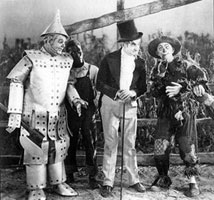 Of all the silent Oz films, Wizard of Oz (1925) could well be the best, but that's largely because none of them are especially good.
Of all the silent Oz films, Wizard of Oz (1925) could well be the best, but that's largely because none of them are especially good.
It pretty much tosses any of Baum's original story & riffs for slapstick purposes on the popular images of characters from the novel The Wonderful Wizard of Oz (1900), adding characters not to be found in any of the Baum books.
It was scripted by Frank Joslyn Baum, the novelist's son, with assists from Larry Semon & Leon Lee who better understood silent comedy.
Oliver Hardy, Spencer Bell, & Larry Semon become, respectively, Tin Man, Cowardly Lion, & Scarecrow, but only in the context of donning disguises; they're otherwise ordinary farmhands. This is the only version in which the Tin Man turns villainous.
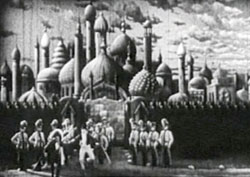 The first contact with Oz is when assassins arrive by airplane to Kansas intending to do harm to Dorothy (played by Semon's wife, Dorothy Dwan). The first contact with Oz is when assassins arrive by airplane to Kansas intending to do harm to Dorothy (played by Semon's wife, Dorothy Dwan).
They'd've gotten her, too, but she's saved by the tornado. When she & friends get to Oz, they become involved in political machinations, as it turns out Dorothy is the rightful heir to the throne.
After the villainous Minister Kruel (Josef Swickard) is overcome, Dorothy will fall in love with Prince Kynd (Bryant Washburn) for the convenience of the long-in-coming conclusion. As a feature-length production there are many events, but in general pratfalls count for a lot more than story.
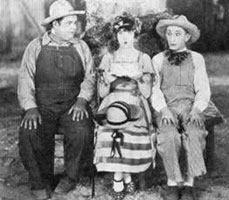 It has to be appreciated in context of the time, as the jokes haven't stood the test of decades supposing they were ever funny. Yet when it is compared to other silent versions, it comes off as an improvement. It has to be appreciated in context of the time, as the jokes haven't stood the test of decades supposing they were ever funny. Yet when it is compared to other silent versions, it comes off as an improvement.
The amount of fantasy that has been stripped away in favor of "realistic" mix of slapstick & melodrama may well disappoint Oz fans.
But it will entertain fans of silent film clowns, as the tale is much more about Semon's character(s) than Dorothy's. He's no Keaton, but he'll do in a pinch.
A lousy copy of this film long in distribution includes the unfortunate addition of a needless narrator (Jacqueline Lovell) & an abysmal musical soundtrack; it is best to just turn the sound off. A version with color tints restored is better, not having the intrusion of a narrator, & possessing a more apropos orchestral soundtrack.
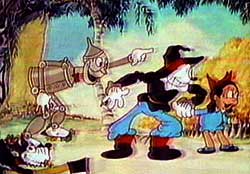 A mainly silent cartoon, save for the Carl Stalling musical soundtrack & FX sounds, Wizard of Oz (1933) produced in Canada was withheld from distribution when new, due to copyright confusion caused by Baum. A mainly silent cartoon, save for the Carl Stalling musical soundtrack & FX sounds, Wizard of Oz (1933) produced in Canada was withheld from distribution when new, due to copyright confusion caused by Baum.
Baum provided the script for the cartoon, which has the distinction of being the first version to depict Kansas in black & white, becoming gaudilly colorful only when Dorothy & Toto are taken into Oz.
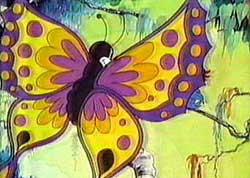 Dorothy immediately meets the Tin Man & Scarecrow (there's no Cowardly Lion in this synoptic version). Dorothy immediately meets the Tin Man & Scarecrow (there's no Cowardly Lion in this synoptic version).
They head right for the Emerald City, getting a big parade & a meeting with the wizard.
The wizard does have some cool tricks, like materializing cupie dolls which perform as a choras line.
Toto runs off with the magic wand, which the wizard needs to stop a strange egg from growing more & more & more. The fear is that it will hatch something gigantic, but for climax the enormous egg bursts open & has only a tiny chick in it.
It's not a particularly good cartoon in its own right, but it's pleasing enough as an Oz oddity.
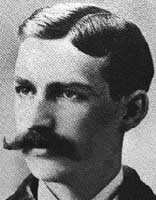 L. Frank Baum: The Man behind the Curtain (2005) is a pleasant documentary in a minor note, about the life & career & social life of the author of books, plays, poems & musicals.
L. Frank Baum: The Man behind the Curtain (2005) is a pleasant documentary in a minor note, about the life & career & social life of the author of books, plays, poems & musicals.
We learn of his parents, his family, his youthful wanderings as a salesman, followed by his writing success in middle age, followed by bankruptcy & his comeback, & finally his health problems & death.
It's in great part an endearing love story about Frank & Maud. Interviews with living members of his family adds a strong note of immediacy to the subject.
As Baum finally settled in Hollywood, the documentary has this added interest for the early history of how Hollywood became the cinema capital of the world.
copyright © by Paghat the Ratgirl
|
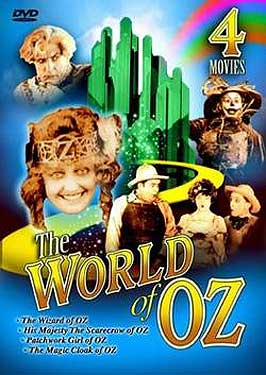

 Dorothy, Scarecrow holding Toto, & a couple farm animals (Hank the Mule & Imogene the Cow) take refuge in a haystack when the tornado is coming.
Dorothy, Scarecrow holding Toto, & a couple farm animals (Hank the Mule & Imogene the Cow) take refuge in a haystack when the tornado is coming. Big Toto befriends the Lion, plus there's the giant kitty-cat Eureka. Off they all go, farm animals, wild animals Scarecrow, & Dorothy too, finding the Tin Woodman (Robert Z. Leonard) rusted solid. After being oiled he joins the troupe. Everybody dances happily.
Big Toto befriends the Lion, plus there's the giant kitty-cat Eureka. Off they all go, farm animals, wild animals Scarecrow, & Dorothy too, finding the Tin Woodman (Robert Z. Leonard) rusted solid. After being oiled he joins the troupe. Everybody dances happily.
 Dorothy meanwhile is enslaved by Mombi (Mae Wells) the one-eyed Wicked Witch. She'll eventually be liberated by Pon, & they will set out together to save the princess.
Dorothy meanwhile is enslaved by Mombi (Mae Wells) the one-eyed Wicked Witch. She'll eventually be liberated by Pon, & they will set out together to save the princess. Fun because of its great age, His Majesty the Scarecrow of Oz is awfully primitive, sloppily photographed, & hoky, needing some forgiveness to fully appreciate.
Fun because of its great age, His Majesty the Scarecrow of Oz is awfully primitive, sloppily photographed, & hoky, needing some forgiveness to fully appreciate.
 Donkey Nicodemus disliked city life & wanted to go back to their humble riverside home. On his way he was waylaid by robbers, who have a forest camp where they play jacks, & where they have a kidnapped little girl, Mary.
Donkey Nicodemus disliked city life & wanted to go back to their humble riverside home. On his way he was waylaid by robbers, who have a forest camp where they play jacks, & where they have a kidnapped little girl, Mary.
 The first contact with Oz is when assassins arrive by airplane to Kansas intending to do harm to Dorothy (played by Semon's wife, Dorothy Dwan).
The first contact with Oz is when assassins arrive by airplane to Kansas intending to do harm to Dorothy (played by Semon's wife, Dorothy Dwan). It has to be appreciated in context of the time, as the jokes haven't stood the test of decades supposing they were ever funny. Yet when it is compared to other silent versions, it comes off as an improvement.
It has to be appreciated in context of the time, as the jokes haven't stood the test of decades supposing they were ever funny. Yet when it is compared to other silent versions, it comes off as an improvement.
 Dorothy immediately meets the Tin Man & Scarecrow (there's no Cowardly Lion in this synoptic version).
Dorothy immediately meets the Tin Man & Scarecrow (there's no Cowardly Lion in this synoptic version).